B2B email marketing is one of the best ways to grow your business’s income without spending money on ads or other pay-per-click marketing methods.
It also happens to be one of the highest ROI marketing channels you can invest in.
Today, I share our exact B2B email marketing process, plus five examples to inspire your next email blast.
%(tableofcontents)
Let’s dive in!
B2B vs. B2C Email Marketing: What’s The Difference?
B2B (Business to Business) email marketing is very different from B2C (Business to Consumer) email marketing in a few ways:
-
Who is making the decisions (and how many people are involved in the decision-making process).
-
How long it takes for a buying decision to be made (e.g., a longer “buying cycle”).
-
The time of day emails are opened.
Unless you’re marketing to solopreneurs (such as freelancers or small business owners), the recipients will probably need to get approval from more people than just themselves. This naturally means a longer time between contact and purchase.
Additionally, while most B2C emails are opened in the afternoon (after work), most B2B emails are opened between the hours of 9-5 (typical working hours). However, the entrepreneurial and work from home types often check email on weekends more than weekdays on average.[*]
That said, your specific audience may vary, so you can’t just go off “normal” good times. Always be testing!
How to Write B2B Marketing Emails
Now that you understand the difference between B2C and B2B email marketing, let’s talk about how to approach it.
Define Your Target Audience (Ideally The Decision-Maker)
Ask yourself:
Who is the decision-maker for my ideal client? Are they on my email list, or do I need to get my audience to convince the actual decision-maker?
This is the most important question when creating your email copy and CTAs. If your subscribers are not the decision-makers, you need to help your audience to convince the appropriate people to use your services or purchase your products.
For example, you might be selling software that helps email marketers improve the conversion rates and revenue from their emails. However, not all email marketers are the decision-makers; many email marketers work for the owner as a freelancer or employee.
In that case, you need to educate the email marketer, but also help them convince the decision-maker that your product or service will bring the business a positive ROI.
To figure out who is on your list, send a quick survey that takes no more than 30 seconds to fill out. Here are the questions:
-
Why did you sign up for the [brand name] email list?
-
[Long-form text]
-
-
What can we help you accomplish?
-
[Long-form text]
-
-
Do you own the business or are you an employee/contractor?
-
I own the business.
-
I’m an employee or contractor.
-
Other (please explain).
-
You can do this for free with Google Forms. Create a new blank form and fill it out like you see below.
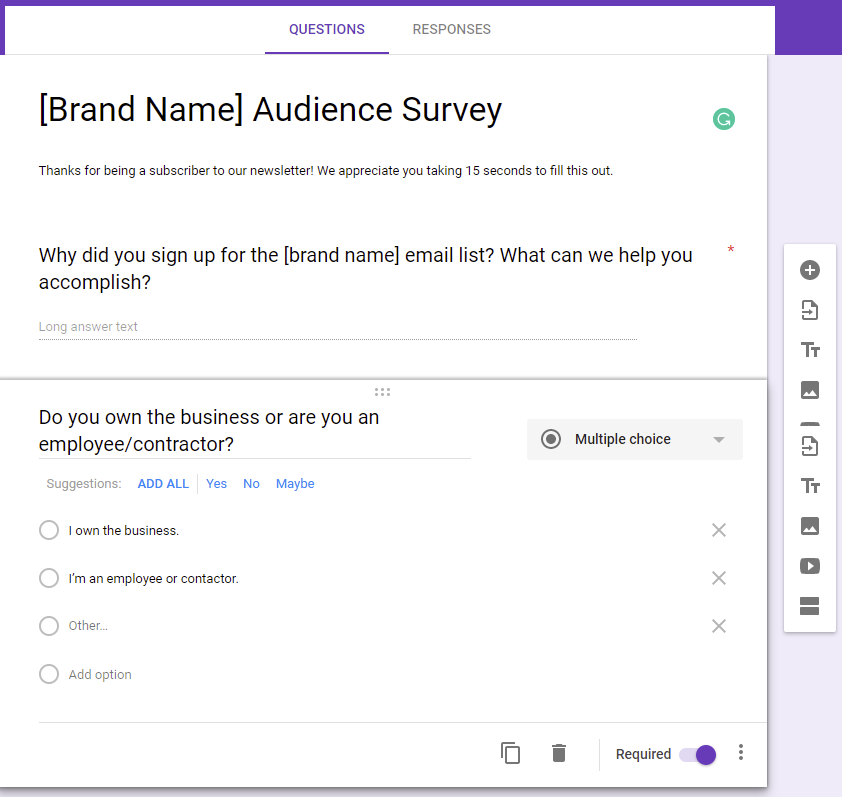
Find Out What Your Audience Cares About
Yes, they want to make more money. But why do they want to make more money?
Is it to spend more time with their family? Travel the globe? Grow a Fortune 500 business? To feel like they matter? To satisfy investors? Something else?
Obviously, the answer will vary widely based on your target market and even from person to person. However, you’ll start to notice patterns if you do your homework.
For example, many online business owners are digital nomads; they desire to travel freely without being bogged down by an office, employees, or needing to work set hours. Because of this, they care a lot about automation and efficiency.
Another example would be CEOs of Fortune 500 companies. They also value automation and efficiency, but are typically not the people on your email list. Instead, you’re writing to their employees, who usually care about getting a raise, doing a good job, being recognized by peers, etc.
You could add a question to the survey you’re sending out in the previous step to figure this out, such as “What do you need help with?” or “What’s your biggest motivation for signing up for our email list?”. However, most people won’t answer this completely honestly or even know the true reason.
Instead, look at the forums where your audience spends time. Almost every audience has a subreddit on Reddit that you can find by searching “[niche] subreddit.”
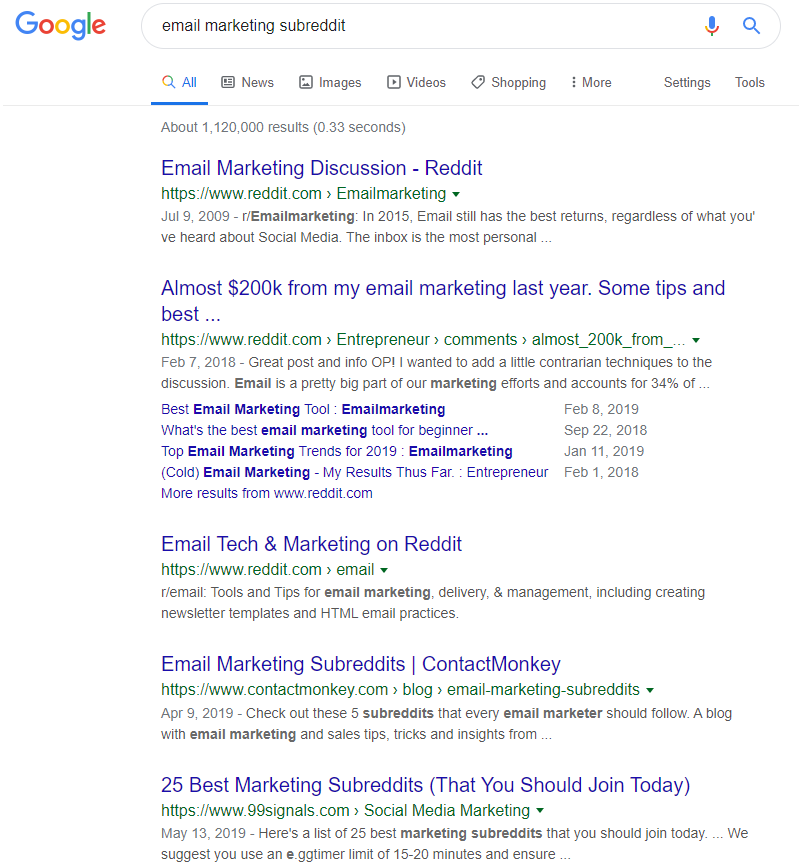
Another great way to figure this out is to schedule calls with your email subscribers. Send an email to your list offering a free call to help them grow their business, then chat with them about what they care about while you're offering them help.
Make Sure You’re Adding Value
Now that you know who you’re talking to and what they care about, it’s time to start writing your email.
From your subject line to your email copy, everything should add value. That means no fluff and no BS. If you’re offering a discount, get to the point with it. If you’re sharing an article that can improve their business, tell them why they should care right away.
For example, this email by Content Marketing Institute shares an article on how to do an SEO audit in a few hours, with no fluff, and an immediate CTA:
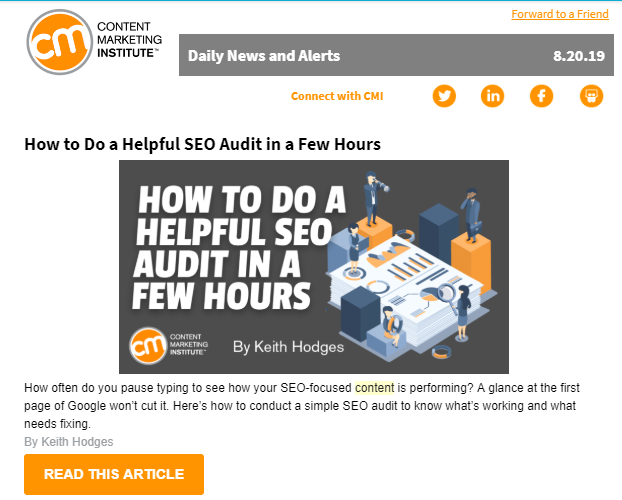
Keep Your Email Short And Straightforward
I get over 30 emails per day to my primary inbox, and I keep that inbox on lockdown. Most people get well over 100 emails per day between marketing emails, business emails, spam, etc.
What I’m saying is this: Ain’t nobody got time to read your life story.
Keep your marketing emails to a paragraph or two at most (unless you have a good reason to write a longer email, such as you tested long-form storytelling emails and you had a good response with your audience).
WordStream is great at this, with an immediate CTA button followed by just a few sentences of explaining text.

Make Your Call To Action Obvious
No matter if you want your readers to buy something, read an article, fill out a survey, or enter a giveaway, make the CTA obvious.
This can easily be done by linking to your offer from the first or second sentence and adding a button at the end of the email, or using a big image with a button like WordStream did in the example above.
Keep Media To A Minimum
You’re not selling to consumers who need lots of fancy pictures. You’re selling to extremely busy professionals who have jobs to do.
In other words, don’t do this:

Instead, if you’re going to use media, do it sparingly, like this Best Self does below. Note that this isn’t strictly a B2B email, but it gets the point across.
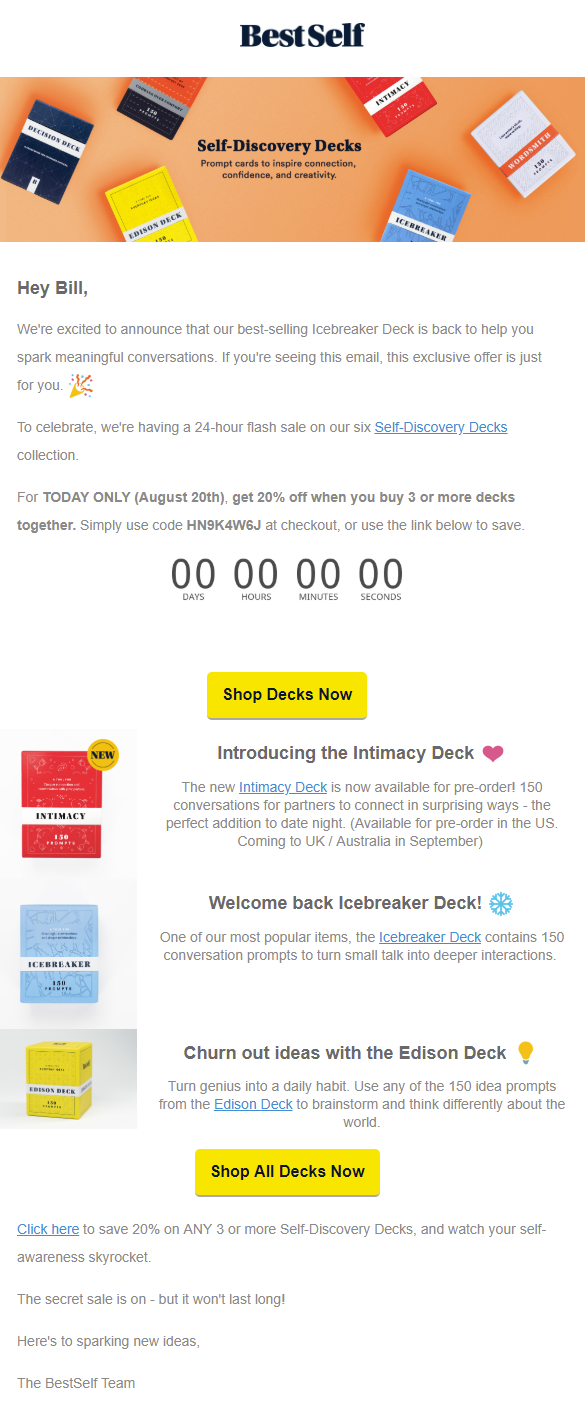
#1 Rule of Marketing: Always Be Testing
You might find that your specific list loves tons of images, long-form content, and beating around the bush. No two lists are the same.
To figure it out, run tests! Send a long-form email once in a while to see the response rates. Test a few images (or videos) to see if you get higher engagement.
Eventually, you’ll dial in on exactly what works for you.
5 Examples of B2B Email Marketing
Whether you’re an email marketing rookie or a seasoned pro, looking at successful examples is a great way to bypass trial and error to see what works.
Here are five real-life examples of B2B email marketing you can use as inspiration.
1. Sumo’s Marketing Emails
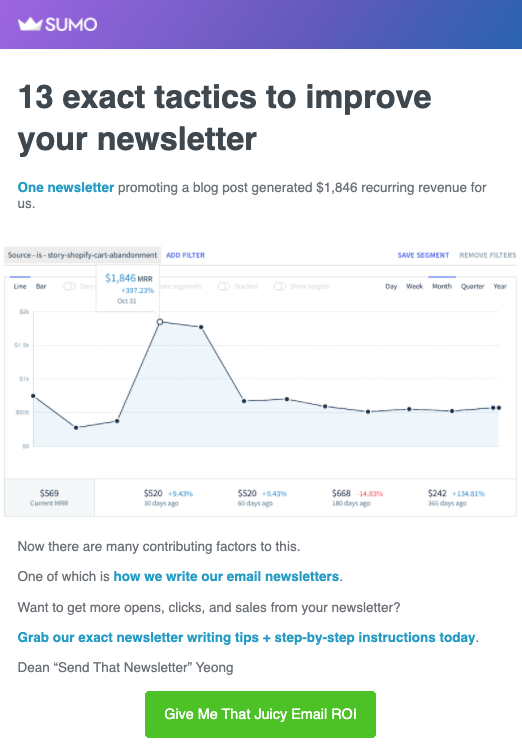
Subject line: 13 exact tactics to improve your newsletter
Target Audience: Business owners and email marketers
Our main audiences are business owners and email marketers, particularly those running a business online. Our emails are short and to the point, with multiple CTAs via links and a button, and always make it clear what the value is.
2. Brian Dean’s SEO Emails

Subject line: SEO Expert
Target Audience: Business owners
Brian Dean targets business owners who want to learn how to master SEO. His emails are even shorter and simpler than ours at Sumo, and he gets right to the point.
The very first sentence is a question about what you — the reader — desire. Then he includes a follow-up question to catch people who think to themselves “I’m already an SEO expert.”
3. Chris Von Wilpert’s Content Marketing Emails
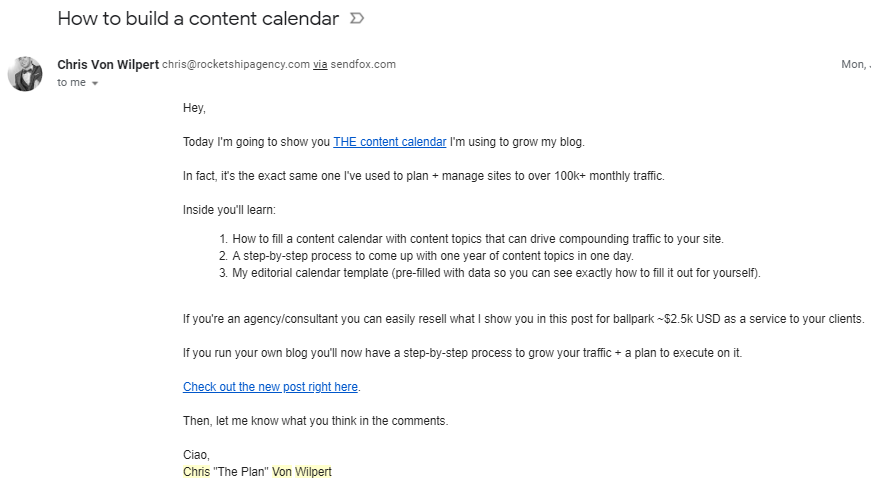
Subject line: How to build a content calendar
Target Audience: Business owners and marketing professionals
Chris Von Wilpert targets business owners and marketing professionals who want to use content marketing to grow their business. Anyone who studies content marketing knows how important a content calendar is; he makes it even more desirable by stating he uses this template to grow sites to over 100k+ monthly traffic.
I also like how he writes, “Inside you’ll learn” with some specific bullet points of what you’ll get when you click the link.
4. Kai Davis’s Freelancer Newsletter

Subject line: Why use many keys when few keys do trick?
Target Audience: Freelancers and small agency owners
Kai Davis targets freelancers and small agency owners with his daily email newsletter.[*]
His emails are longer than other examples on this list because he uses the mini-blog-post style. The value is in the email, not in an external blog post, and his CTA is usually booking a free consulting call with him to see if he’s a good fit to work with you as a coach.
5. WordStream’s Agency Email
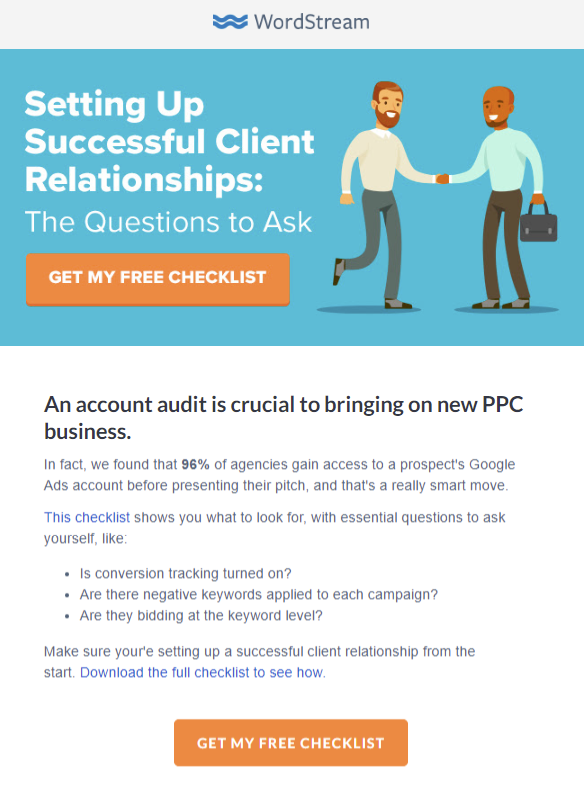
Subject line: Acquire Clients That Stay [Checklist for Success]
Target Audience: Professionals and agencies
WordStream helps Search Engine Marketing (SEM) professionals and agencies acquire more clients and learn more about PPC advertising.
Like Sumo, their emails get straight to the value. In this example, a checklist for acquiring great clients. What they do really well is include a button inside their header image to create a CTA above the fold in their email.
Pro Tip: You can create high-quality images for your emails without being a designer with a tool like Canva or Visme.
Get 5 More B2B Email Marketing Examples
At this point, you should have a good idea of how to send marketing emails to your list. But there’s always more to learn.
Want to up your email marketing game?
Click the button below to get my B2B email marketing swipe file, with five additional B2B email examples and exactly why they work so well.
Add A Comment
VIEW THE COMMENTS